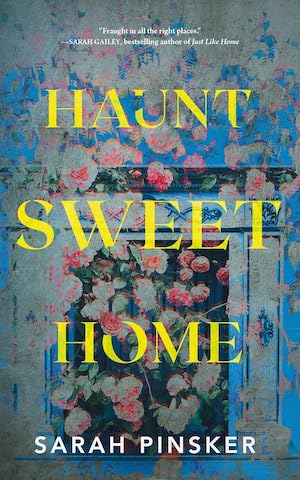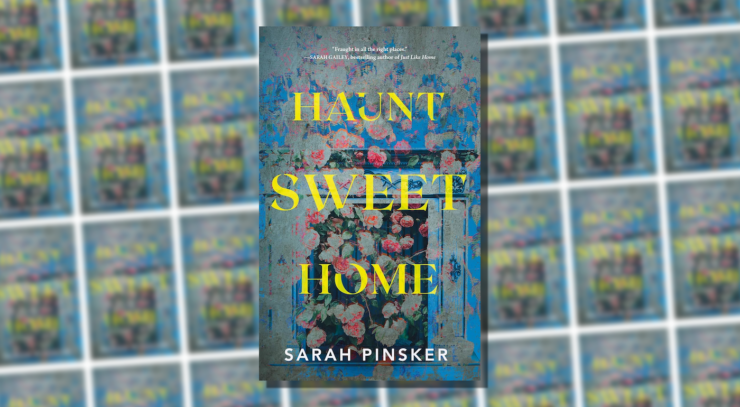In ghost stories, things left undone in life are often the occasion for hauntings: the child abandoned, the love undeclared, the crime unavenged. In Haunt Sweet Home, the new novella by Sarah Pinsker, things left undone and the potentials left unrealized are the domain of the living narrator, Mara. She’s in her mid-twenties, without a stable job, much less a career, when she finds herself offered a behind-the-scenes role on the long-running television show that her cousin Jeremy hosts. Her car is running on fumes, her wallet is just about empty, and she has little desire to take another shot at community college. She accepts.
Pinsker has written two prior novels, A Song for a New Day and We Are Satellites, as well as dozens of short stories, some of which have been collected in Lost Places and Sooner or Later Everything Falls Into the Sea. She has won the Hugo, the Nebula, and the World Fantasy Award, but she’s not an author who repeats herself. Her first novel, published pre-COVID, was about plague-mandated lockdowns in a future America; her second was about the social changes wrought by mental augmentations. Her stories veer between fantasy and science fiction; she writes widely and well.
Where Pinsker consciously seeks to avoid repetition, the producers of Haunt Sweet Home, the television show on which Mara works as a non-union personal assistant, thrive by telling the same story every week. As the book opens, the show, a combination home makeover and ghost-hunting program, is entering its seventh season. In each episode, Jeremy meets the owner of a fixer-upper and investigates whether someone’s new house is haunted. Thanks to Mara and her colleagues, armed with fog machines, flashlights, and sinister recordings, the houses always prove to have supernatural inhabitants. Mara works nights: She clambers over rooftops to drop MP3 players down chimneys, wedges herself between bookshelves in a home’s centerpiece two-story library, and turns on the fog machine in the overgrown orchard abutting a newly purchased homestead. While she’s in the orchard, she makes two discoveries: an untended gravestone, the name on it worn to illegibility, and a lightning-struck apple tree that seems to call out for a carver’s knife. She takes a piece of the wood with her.
Buy the Book


Haunt Sweet Home
You see, Mara comes from a family of artists and musicians. She’s one of just two members of the family who doesn’t play an instrument, while her grandmother was, until arthritis locked up her hands, a world-renowned sculptor of wood who exhibited at museums like the Whitney. At family gatherings, everyone in the extended family gathers around a fire pit on the wooden “thrones” that Mara’s grandmother carved for each individual according to their personality. One throne looks like a lion, another like a dragon. Mara is the only member of the family without a bespoke seat; her grandmother had to put down her tools before she could carve a seat for her youngest granddaughter.
In her offtime, when she’s not sleeping at the motel where her fellow crew members are based, wondering why her cousin ignores her, Mara begins to carve the wood. She doesn’t feel like much of an artist compared to her grandmother, but self-expression proves addictive, even enthralling. Soon after she begins whittling away at the apple wood, she meets Jo, a fellow Haunt Sweet Home crewmember who helps out her hauntings. When Mara takes her new friend home for a long weekend, the whole family loves her for her friendliness, her enthusiasm, and her fiddle-playing. A resentful Mara starts thinking that Jo is better at being Mara than Mara herself ever could be, and there may be a little bit of truth to that. Jo, as it turns out, has a lot to teach Mara about the world, her place in it, and her prospects.
Pinsker has a knack for portraying a flailing, failing young adult. Readers will appreciate Mara’s gifts, understand her shortcomings, and sympathize with her predicament, even while realizing that many of her problems are self-created. Pinsker remembers twenty-something awkwardness when faced with the prospect of transforming work acquaintances into personal friends; she knows the mixed shame and relief of falling back on family, the embarrassed admissions of failure, and the pained sympathy of conventionally successful relatives. All of which, I admit, sounds depressing, but Pinsker also has a comic lightness, a sense of the ridiculous, and an abiding charity. If we shudder, we laugh too.
Mara’s carving comes from her deep sense of “Frustration, aimless ambition, the conviction that everybody knew where they were going except for me.” When at last she shows it to her grandmother, whose opinion she values as much as she fears, both her skill and emotion receive a tremulous acceptance: “Bleeding for your art is fine, but it looks like you hit an artery. Is there any of you left?”
As it turns out, there’s quite a bit of Mara left, and the book ends with both her emotional and occupational prospects more open than they’ve ever been. Mara emerges from her summer of televised haunting with a new outlook, a new vocation, an unusual new friend, and even the prospect of a union job. Would that everyone could be so lucky.
As with Mara’s carving, there are some rough edges to Haunt Sweet Home. We’re told that the television show has multiple fan podcasts, some hosted by fans who truly believe there’s no fakery involved. That stretches my disbelief, just as Mara’s family seems almost too perfect in its supportive and quirky artiness. Some part of me wishes Haunt Sweet Home were longer, so that we could learn more about Mara’s colleagues, about the antics of the show’s night crew, and about the way the supernatural works in this world. At other times, I think a shorter book would, paradoxically, have had more emotional heft.
Haunt Sweet Home is a coming-of-age story, and while there is a ghost present, there’s no horror. The operative word in this book’s title is “sweet,” the mood warm, even cozy. If its memory haunts the reader, it will be a pleasant haunting indeed.
Haunt Sweet Home is available from Tordotcom Publishing.










